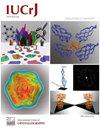使用深度学习预测可以发现 PDB 沉积中的大量寄存器错误。
IF 3.6
2区 材料科学
Q2 CHEMISTRY, MULTIDISCIPLINARY
引用次数: 0
摘要
蛋白质数据库(PDB)中信息的准确性对于利用蛋白质结构信息的无数下游应用来说非常重要。尽管已经尽了最大努力,但偶尔引入误差是不可避免的,尤其是在实验数据分辨率有限的情况下。一种新颖的蛋白质结构验证方法基于发现结构模型中观察到的残基接触和距离与 AlphaFold2 等方法计算预测的残基接触和距离之间的不一致。这种方法尤其适用于检测寄存器错误。重要的是,这种新方法与基于立体化学或图谱-模型一致性的传统方法是正交的,并且与分辨率无关。在这里,通过扫描 PDB 中 3-5 Å 分辨率的结构,可以识别出数千个可能的套准错误。与大多数方法不同的是,应用这种方法会对受影响区域的配准产生建议性修正,即使实施有限,也能在绝大多数情况下改善精炼统计。虽然存在一些局限性和混杂因素(如折叠转换蛋白),但这种方法有望广泛应用于发现当前入库中的潜在问题,并通过其在 CCP4 中的实施和传播,帮助确保未来入库的准确性。本文章由计算机程序翻译,如有差异,请以英文原文为准。
Using deep-learning predictions reveals a large number of register errors in PDB depositions
A novel structure-validation method is applied to PDB depositions at 3–5 Å resolution, revealing large numbers of putative register errors.
The accuracy of the information in the Protein Data Bank (PDB) is of great importance for the myriad downstream applications that make use of protein structural information. Despite best efforts, the occasional introduction of errors is inevitable, especially where the experimental data are of limited resolution. A novel protein structure validation approach based on spotting inconsistencies between the residue contacts and distances observed in a structural model and those computationally predicted by methods such as AlphaFold2 has previously been established. It is particularly well suited to the detection of register errors. Importantly, this new approach is orthogonal to traditional methods based on stereochemistry or map–model agreement, and is resolution independent. Here, thousands of likely register errors are identified by scanning 3–5 Å resolution structures in the PDB. Unlike most methods, the application of this approach yields suggested corrections to the register of affected regions, which it is shown, even by limited implementation, lead to improved refinement statistics in the vast majority of cases. A few limitations and confounding factors such as fold-switching proteins are characterized, but this approach is expected to have broad application in spotting potential issues in current accessions and, through its implementation and distribution in CCP4, helping to ensure the accuracy of future depositions.
求助全文
通过发布文献求助,成功后即可免费获取论文全文。
去求助
来源期刊

IUCrJ
CHEMISTRY, MULTIDISCIPLINARYCRYSTALLOGRAPH-CRYSTALLOGRAPHY
CiteScore
7.50
自引率
5.10%
发文量
95
审稿时长
10 weeks
期刊介绍:
IUCrJ is a new fully open-access peer-reviewed journal from the International Union of Crystallography (IUCr).
The journal will publish high-profile articles on all aspects of the sciences and technologies supported by the IUCr via its commissions, including emerging fields where structural results underpin the science reported in the article. Our aim is to make IUCrJ the natural home for high-quality structural science results. Chemists, biologists, physicists and material scientists will be actively encouraged to report their structural studies in IUCrJ.
 求助内容:
求助内容: 应助结果提醒方式:
应助结果提醒方式:


